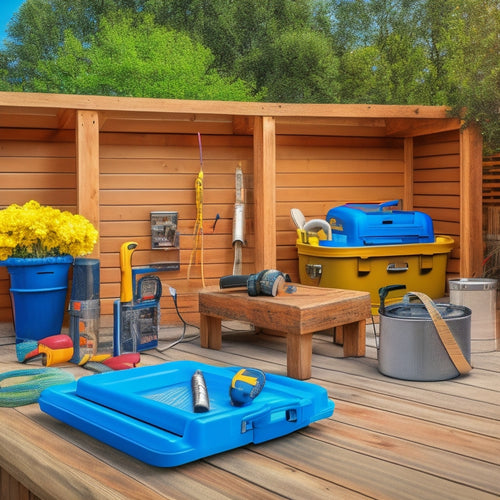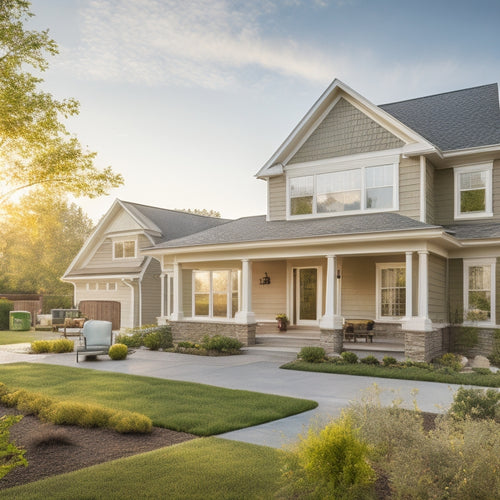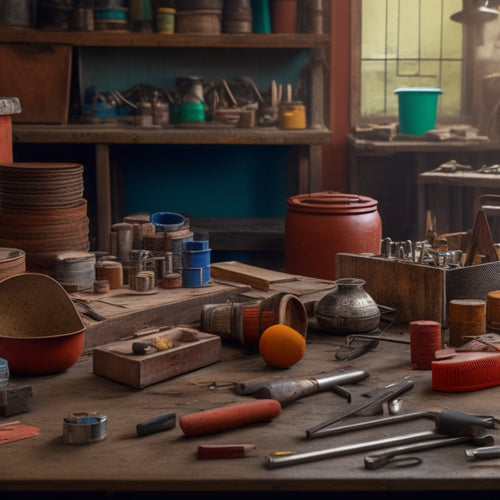
Budget-Friendly Materials for Your Home Renovation Project
Share
As you plan your home renovation project, finding budget-friendly materials is key to turning your design vision into a stunning reality. You can achieve a stylish exterior without breaking the bank by exploring affordable stucco alternatives, such as eco-friendly stucco, EIFS, fiber-cement siding, or stucco-inspired paint. These options offer a range of textured finishes, from rough-hewn stone to smooth modern concrete, and can be combined in creative ways to yield a unique, budget-friendly look. From sourcing affordable suppliers to DIY application and mixing techniques, there are numerous ways to save without sacrificing style - and there's more to uncover as you start building your dream home.
Key Takeaways
- Eco-friendly stucco alternatives like EIFS, fiber-cement siding, and cement-based siding offer affordable and sustainable options for home renovation projects.
- Buying stucco materials in bulk and negotiating with suppliers can significantly reduce costs, making it a budget-friendly option.
- DIY stucco application and mixing techniques can help reduce labor costs, but require proper techniques for successful application.
- Economical block finish options like split-face block and smooth finishes can enhance curb appeal without breaking the bank.
- Reusing old stucco materials reduces renovation costs, minimizes waste, and promotes environmental sustainability.
Affordable Stucco Alternatives
As you envision your dream home's exterior, you may be drawn to the rustic charm of stucco, but its hefty price tag can be a major deterrent.
Fortunately, there are affordable stucco alternatives that can replicate the same look and feel without breaking the bank. One option is to opt for eco-friendly stucco, made from natural materials like lime putty and sand, which not only reduces the environmental impact but also offers a unique, organic aesthetic.
Another alternative is to investigate different textured finishes, which can add depth and visual interest to your exterior walls.
From rough-hewn stone to smooth, modern concrete, the possibilities are endless. By combining these finishes with a coat of stucco-inspired paint, you can achieve a similar look to traditional stucco at a fraction of the cost.
With a little creativity, you can create a stunning exterior that's both budget-friendly and environmentally responsible.
Buying Stucco Materials on a Budget
As you plan your stucco renovation, you're likely wondering how to allocate your budget effectively.
Let's break down the costs: from the base coat to the finish coat, every layer adds up.
Stucco Cost Breakdown
Texture and durability converge in stucco, a timeless exterior finish that enhances your home's curb appeal.
When considering stucco for your home renovation, understanding the cost breakdown is essential to staying within your budget. A typical stucco installation involves three coats: scratch, brown, and finish.
The cost of stucco materials can range from $3 to $9 per square foot, depending on the type and quality of the stucco. For a 1,000-square-foot exterior wall, you can expect to pay around $3,000 to $9,000 for the materials alone.
Labor costs, which vary depending on location and contractor rates, can add an additional $2 to $5 per square foot.
To save money, consider DIY stucco installation, which can reduce labor costs considerably. However, keep in mind that stucco durability is heavily dependent on proper installation techniques, so if you're not experienced, it's best to hire a professional.
With proper installation and maintenance, stucco can last for decades, making it a worthwhile investment for your home's exterior.
Stucco Alternative Options
Behind the allure of stucco's durability and aesthetic appeal lies an intimidating price tag, prompting many homeowners to investigate alternative options that won't break the bank.
You're not alone in your quest for a budget-friendly solution that still delivers on style and functionality.
Fortunately, there are several stucco alternative options that can provide a similar look and feel without the hefty price tag. Consider the following:
-
EIFS (Exterior Insulation and Finish System): A cost-effective alternative to traditional stucco, EIFS offers a similar textured finish and can be installed for a fraction of the cost.
-
Fiber-Cement Siding: This sustainable material mimics the look of stucco while providing superior durability and resistance to weathering.
-
Acrylic Stucco: A more affordable alternative to traditional stucco, acrylic stucco offers a similar aesthetic appeal and can be installed at a lower cost.
- Cement-Based Siding: This eco-friendly option provides a textured finish similar to stucco and can be stained or painted to match your desired color scheme.
These alternatives not only save you money but also provide a unique opportunity to incorporate sustainable materials into your home renovation project.
DIY Stucco Application Tips
As you prepare to apply stucco to your home's exterior, you'll need to become proficient in the art of mixing the compound to the perfect consistency.
Next, you'll learn how to apply the stucco in smooth, even layers, making sure to cover every inch of your exterior walls.
Mixing the Compound
With your stucco ingredients gathered, it's time to combine them into a workable compound. Mixing stucco requires some skill and patience, but with the right techniques and tools, you'll be able to create a consistent and strong mixture.
To achieve the perfect mix, follow these essential stucco mixing techniques:
-
Start with a clean mixer: Confirm your mixing bucket or wheelbarrow is free from any debris or old stucco residue.
-
Add ingredients in the right order: Begin with the dry ingredients (cement, sand, and lime), then gradually add water while mixing.
-
Use the right mixing tool: Invest in a budget-friendly mixing tool like a stucco paddle or a mixing stick to achieve a smooth, lump-free consistency.
- Mix in small batches: Divide your ingredients into smaller batches to maintain control over the mixing process and avoid wasting materials.
Applying the Stucco
About three-quarters of the way through your stucco project, you're finally ready to apply the mixture to your wall. It's crucial to use the right stucco application techniques to achieve a weather-resistant finish. Start by applying a scratch coat, which helps the final layer adhere to the wall. Hold the trowel at a 45-degree angle and spread the mixture evenly, making certain to fill all gaps and corners.
| Layer | Thickness | Purpose |
|---|---|---|
| Scratch Coat | 1/4 inch | Adhesion and base layer |
| Brown Coat | 1/2 inch | Strength and durability |
| Finish Coat | 1/8 inch | Weather-resistant finish |
As you apply each layer, use a level to verify the surface is even and a trowel to smooth out any imperfections. Apply the brown coat after the scratch coat has dried, and finally, the finish coat once the brown coat is set. Remember to work in small sections, about 4 feet by 4 feet, to maintain control and achieve a uniform finish.
Finishing the Surface
Get ready to put the finishing touches on your stucco project, and make it look like a pro did it!
You've applied the stucco, and now it's time to add some texture and visual appeal.
To achieve a professional-looking finish, follow these essential steps:
-
Float and trowel: Use a float to apply a thin layer of stucco, then use a trowel to create the desired texture. Experiment with different trowel angles and pressures to achieve unique texture techniques.
-
Add a finish coat: Apply a thin layer of stucco, and use a trowel or special finish tool to create a smooth, even surface.
-
Seal the deal: Apply a stucco sealer to protect your surface from the elements and enhance its appearance.
- Inspect and touch up: Walk around your project, inspecting for any imperfections or areas that need a bit more attention. Make any necessary repairs, and you're done!
Economical Block Finish Options
As you envision your renovated home, the exterior aesthetic takes center stage, and the finish of your concrete blocks plays a starring role. The right block finish can enhance your home's curb appeal while staying within budget.
You can achieve a high-end look without breaking the bank by exploring economical block finish options. One way to add visual interest is by incorporating block texture techniques. A split-face block finish, for instance, exposes the aggregate beneath the surface, creating a unique, rough-hewn look.
Alternatively, a smooth finish can provide a sleek, modern appearance. When combined with clever economical block designs, these finishes can create a stunning exterior that belies their budget-friendly price tag.
To take your block finish to the next level, consider adding a decorative cap or banding to accentuate your home's design features. These subtle touches can make a significant impact on your home's overall aesthetic, all while keeping costs in check.
Finding Cheap Stucco Suppliers
With your block finish in place, it's time to turn your attention to the exterior cladding that will bring your design vision to life.
Stucco is a popular choice for many homeowners due to its durability, low maintenance, and versatility in design. To save on costs, finding a cheap stucco supplier is essential.
Here are some tips to help you find an affordable stucco supplier:
-
Compare suppliers: Research and compare prices from different stucco suppliers in your area to find the best deal. Make sure to check the quality of their products and services before making a decision.
-
Check local directories: Look for local stucco directories or online platforms that connect you with stucco suppliers in your area. This can help you find suppliers that offer competitive pricing.
-
Ask for referrals: Ask friends, family, or neighbors who've recently completed a stucco project for recommendations. They can provide important knowledge into the supplier's pricing and service quality.
- Negotiate: Don't be afraid to negotiate with the supplier to get the best price. If you're ordering a large quantity, you may be able to get a discount.
Mixing Your Own Stucco
Step into the world of DIY stucco mixing, where you can take control of your home renovation project and save even more money. By mastering stucco mixing techniques, you'll avoid common mixing mistakes that can lead to a subpar finish or even structural issues.
Start by gathering the essential ingredients: Portland cement, sand, water, and lime.
Next, prepare your mixing area by laying down a tarp or old sheets to contain the mess. Wear protective gear, including gloves, goggles, and a dust mask.
Now, combine 1 part cement to 3 parts sand in a large mixing bucket. Gradually add water while mixing the ingredients with a shovel or mixing stick until you achieve a workable consistency – not too runny, not too thick.
Avoid common mixing mistakes like overmixing, which can lead to a weak stucco mixture. Also, be mindful of the temperature and humidity, as these factors can affect the final product.
With practice and patience, you'll be able to create a high-quality stucco mixture that meets your project's specific needs. By taking the DIY route, you'll not only save money but also gain a sense of accomplishment and satisfaction in your work.
Reusing Old Stucco Materials
You're likely to find old stucco materials lying around your construction site or in your garage, just waiting to be repurposed. Instead of tossing them out, consider reusing them to save money and reduce waste.
With a little creativity, you can breathe new life into these materials and give your home renovation project a unique touch.
Here are some benefits of reusing old stucco materials:
-
Cost-effective: Reusing stucco materials can greatly reduce your renovation costs. You won't have to purchase new materials, which can be a huge expense.
-
Environmental benefits: By reusing old stucco, you're reducing the amount of waste sent to landfills and minimizing the environmental impact of your project.
-
Preserve original character: If you're renovating an older home, reusing original stucco materials can help preserve its unique character and charm.
- Develop stucco repair techniques: Working with old stucco materials can help you develop useful stucco repair techniques that can be applied to future projects.
Frequently Asked Questions
Can I Use Stucco on a House With a Metal Frame?
You can use stucco on a house with a metal frame, but you'll need to adapt stucco application techniques, ensuring a secure bond between stucco and metal framing considerations, such as using a compatible bonding agent and specialized fasteners.
How Do I Ensure Stucco Color Consistency Across the Entire Project?
Imagine a Mediterranean-style villa with perfectly uniform stucco tone; to accomplish this, you'll want to perfect stucco mixing techniques, like using a color-controlled batching system, and follow color matching tips, such as creating a reference panel to guarantee consistency across the entire project.
Is Stucco a Good Choice for Homes in High-Wind Areas?
You're wondering if stucco's a good fit for your high-wind area home. The answer lies in its durability and wind resistance. Stucco's ability to withstand harsh gusts depends on proper installation, reinforcement, and a sturdy substrate, ensuring a secure, long-lasting exterior that won't crack under pressure.
Can I Apply Stucco Over Existing Brick or Concrete Walls?
Did you know that 75% of homeowners consider renovation a challenging task? You're taking the first step by asking if you can apply stucco over existing brick or concrete walls. Yes, you can! Proper surface preparation methods, like cleaning and patching, are key, then you can use specialized stucco application techniques.
Does Stucco Provide Any Insulation or Energy-Saving Benefits?
As you consider stucco for your walls, you'll notice it provides some insulation properties, reducing heat transfer and energy loss, which can lead to increased energy efficiency and lower utility bills, making your home cozier and more cost-effective.
Conclusion
As you stand before your newly renovated home, the sun casts a warm glow on the stucco exterior, its texture and color a reflection of your resourcefulness. You think back on the adventure, the alternatives you investigated, the budget-friendly suppliers you found, and the DIY tricks you perfected. And now, as you turn the key, a sense of satisfaction and accomplishment washes over you, just like the first gentle rainfall on your freshly applied stucco, bringing new life to your abode.
Related Posts
-

Protect Your Tools for Outdoor Renovation Success
To guarantee outdoor renovation success, you need to protect your tool investment by understanding warranty and suppo...
-

Streamline Your Exterior Renovation Timeline
To streamline your exterior renovation timeline, you'll need to approach the process strategically. Start by planning...
-

Budget-Friendly Materials for Your Home Renovation Needs
As you initiate your home renovation, you're enthusiastic to find budget-friendly materials that fit your vision with...


